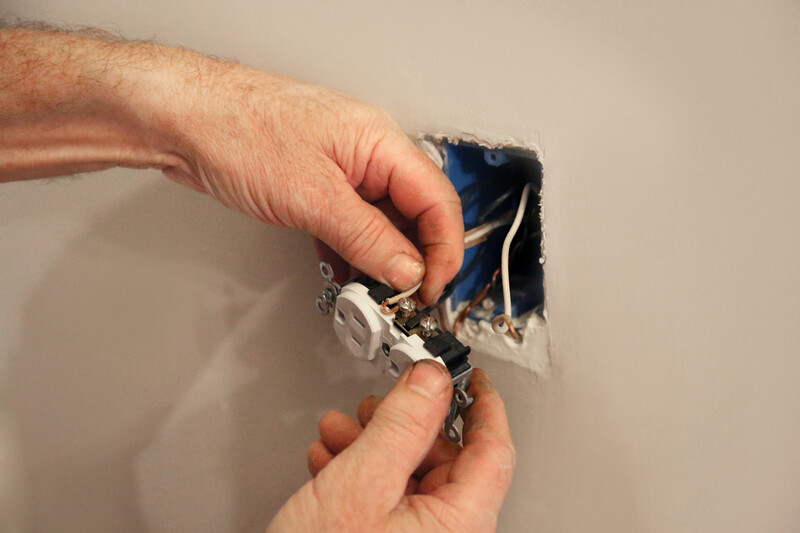- AppliancesElectriciansHVACLandscapingLocksmithPest ControlPlumbingRenovationRoofingT V RepairAll Home Improvement
- Car AccidentClass ActionCorporate LawCriminal DefenseDivorce LawEmployment LawFamily LawFinancial LawLegal AidMedical Injury LawyersMedical MalpracticeReal Estate LawWater Fire RestorationAll Legal
- InvestmentRetirementAll Finance
- Animal InsuranceAutoGeneral InsuranceHealth PolicyHome RentersAll Insurance
- DentalHealth SpecialistsAll Medical
- Animal CareVeterinaryAll Pets
- Auto GlassTowingAll Automotive
5 Common Electrical Problems Homeowners Should Know About

It's easy to take electricity for granted. After all, it's been around since long before you were born, powering everything from refrigerators to blow dryers.
Electrical systems have come a long way since the 1800s, but that doesn't mean they're infallible. Learn more about the five most common electrical problems and how to respond to each one if it happens in your home.
1. Frequent Light Bulb Blowouts
If your light bulbs are blowing out almost as fast as you can replace them, one of the easiest ways to fix the problem is to try a different brand. Cheap light bulbs, such as the ones found at discount stores, don't always hold up to normal residential use. If switching brands doesn't make a difference, you might have a problem with high voltage or arcing electricity. Contact an electrician for help with troubleshooting and repairs.

2. Dead Outlets
Most people don't realize they have dead outlets until they plug in an electronic device and find out there's no power. If this happens to you, the first step is to hit the reset button if the outlet has one. Outlets with ground-fault circuit interrupters (GFCI) have a red button that resets the circuit breaker after something trips it. If the outlet doesn't have a reset button, check your breaker panel. If these quick fixes don't work, you may need to hire an electrician to replace the outlet or address other common electrical problems.
3. Tripped Circuit Breakers
Every circuit in your home is designed to handle a specific amount of electricity. Circuit breakers cut off the flow of energy any time a circuit is overloaded, reducing the risk of fires. Unfortunately, many people use the same circuit for multiple items. For example, refrigerators and ovens draw a lot of power, so they're supposed to be on separate circuits. In an older home, there may not be many electrical outlets in each room, causing homeowners to overload their circuits instead of balancing the energy load appropriately.

If you're always tripping your circuit breakers, start by changing your habits. You may need to use a different outlet for your hair dryer or change the configuration of the appliances in your kitchen. If that doesn't work, the problem could be a short circuit. In your home, the electrical wiring consists of live wire, neutral wire and ground wire. If the hot wire touches either of the other two wires, too much current flows into the circuit. This can also happen if the live wire touches any type of metal.
When the live wire touches the ground wire or the metal grounding box, a ground fault surge occurs. This is a specific type of short circuit that may be caused by poor insulation, exposure to water or damaged wiring. If you notice a burning smell or see what looks like heat damage around one of your outlets, contact a qualified electrician.
More Related Articles
- How Do I Tell If an Electrical Issue Is Serious?
- Can One Bad Outlet Affect Others?
- How to Reset a GFCI Outlet
- What’s in My Electrician’s Van?
- 7 Ways to Save on Your Electric Bill
4. Flickering Lights
Unless it's Halloween, flickering lights are a real nuisance. They make it more difficult to see what you're doing, and there's a chance they could be a symptom of serious electrical issues. Before you call an electrician, note whether the flickering happens in every room or if it's isolated to just one light fixture. If it's just one light, you may need to change the bulb or make sure the current bulb is screwed in tightly.
If the problem affects multiple fixtures in multiple rooms, there's a good chance you have a problem with your electrical system. For example, overloaded circuits and loose electrical connections are common culprits. In this case, it's wise to call an electrician for help with troubleshooting.

5. Warm Light Switches and Outlets
Your light switches and electrical outlets shouldn't be hot to the touch. If they are, they might be overloaded — one of the most common electrical problems in residential buildings. Hot light switches may also be the result of bad wiring or poor installation. One easy fix for hot outlets is to change the way you use appliances and other electric items. If you have multiple appliances plugged into one outlet, for example, separate them and see if that solves the problem.
For switches, it's not as simple as unplugging a few things and waiting to see what happens. It's best to have a licensed electrician diagnose the problem and repair it correctly. Otherwise, a hot light switch could lead to arcing and other fire hazards.
Elocal Editorial Content is for educational and entertainment purposes only. Editorial Content should not be used as a substitute for advice from a licensed professional in your state reviewing your issue. Systems, equipment, issues and circumstances vary. Follow the manufacturer's safety precautions. The opinions, beliefs and viewpoints expressed by the eLocal Editorial Team and other third-party content providers do not necessarily reflect the opinions, beliefs and viewpoints of eLocal or its affiliate companies. Use of the Blog is subject to the
Website Terms and Conditions.The eLocal Editorial Team operates independently of eLocal USA's marketing and sales decisions.



